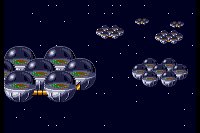|
|

|
PLATFORM
|
Genesis
|
BATTLE SYSTEM
|

|
INTERACTION
|

|
ORIGINALITY
|

|
STORY
|

|
MUSIC & SOUND
|

|
VISUALS
|

|
CHALLENGE
|
Moderate
|
COMPLETION TIME
|
20-40 Hours
|
|
OVERALL

|
+ Generation system is interesting
+ Lots of replay potential
- Combat is frequent and uninspiring
- Battle music is some of the worst in RPG history
- This style of plot needs more exposition
|
Click here for scoring definitions
|
|
|
Phantasy Star III: Generations of Doom has been known as the black sheep of the original series almost since its creation. The game was created by a different team than that responsible for I, II, and IV, which shows in its many aspects that vary from the rest of the Phantasy Star games. Not everything Phantasy Star III tries is an automatic failure, but it suffers from the standards of its time. Introducing a courtship system to determine the children of the current generation would have been a lot more effective with additional dialogue time to let the characters develop personalities, and in 1991 that wasn't a viable option.
The story begins when Prince Rhys's intended bride, a mysterious woman named Maia, is abducted by a dragon on their wedding day. Rhys inadvertently causes big problems for the future in his quest to find Maia, and future generations have to deal with them in the form of his children and grandchildren. This means that Rhys must choose a bride, and the son he has with that bride will choose his own bride also. The paucity of character interaction makes this system rather lackluster, unfortunately. The hero of each generation and his potential brides often speak less than five lines, removing any interest from the proceedings. The overall plot is also quite sparsely told, though at the time this was not an unusual occurrence.
In terms of its effect upon actually playing Phantasy Star III, the generation system is far more interesting. The magical and physical aptitude of Rhys' descendants is determined by the genes that go into them, making the hero of each generation fairly distinct in skill. The party members who join are also partly determined by the women chosen, affecting how battles proceed significantly. The replay value found herein is thus rather high, since it will require four plays to see everything.
Phantasy Star III's actual combat is a random, turn-based system that doesn't vary fundamentally from numerous other games of the time. Its major innovation is making an auto-attack option, which orders all characters to attack every enemy with no additional tactic, be just one button press away. Actually directing the characters instead of having them blindly attack takes much longer. The sub-menu that allows characters to be ordered around closes after a single use , instead of the game allowing every character to be directed in one sequence. This game is also quite obnoxious with its random turn order, making it very difficult to plan an encounter adequately since the characters may not act in the order desired.
 Those are spaceships, people. How they took off and will land is never really explained.
Those are spaceships, people. How they took off and will land is never really explained.
|
|
The menus are similarly archaic in design, particularly when shopping. Buying items is time-consuming when they can only be purchased one at a time and each character has a separate inventory. Buying new equipment is a guessing game, because its effects are never directly shown. A new weapon or armor must be equipped to a character, and the player must pay close attention to the change in statistics, though the shop managers will at least mention when characters cannot use something prior to purchase. One unique aspect is the ability to rearrange the power of spells, which must be done at specialty shops but is cheap and allows the techniques most used to be powered up at the expense of those deemed unnecessary.
Phantasy Star III has a few catchy tunes that mostly play later on, and a lot of mediocre music that will prove unmemorable. Its battle music, however, is one of the least aesthetically appealing compositions ever created. Resembling a child pounding the same few notes onto a 1970's-vintage synthesizer, it makes the auto-battle option far more attractive, because changing this option requires listening to the horrid cacophony for a longer time. The battle music does change based on the enemy being taken by surprise or landing an ambush, but only the final boss has a unique theme, and the horrid nature of the starting battle music taints the soundtrack as a whole.
 Phantasy Star veterans know this being, and it's up to the usual dirty deeds here.
Phantasy Star veterans know this being, and it's up to the usual dirty deeds here.
|
|
Visually the game is unremarkable, save for the invisibility of the characters in battle. Having been seen in Phantasy Star II, the lack of this in its sequel is odd. Enemies do animate in battle, but incompletely; every enemy has a single brief motion that will be seen for every action it takes, and the animations do not vary even when the opponents have been palette-swapped.
Compared to Phantasy Star I and II, this game is not particularly difficult. There are spurts of challenge that occur, such as occasional enemies that kill characters with one or two hits and no warning, but most of the game is manageable with a basic knowledge of how to heal in an RPG. Its length varies somewhat depending upon which hero's quest is the current one, but twenty to twenty-five hours is a reasonable estimate for its completion time.
Phantasy Star III is an interesting game, to be sure. It suffers from the expectations and limitations of its time, which limited the plot to little more than terse declarations of where to go and whom to kill. Its interface has aged poorly, and will cause more frustration than satisfaction. It manages to be moderately enjoyable in short spurts, but would really benefit from a modern remake that exploits the ideas left inadequately explored. Phantasy Star III has not stood the test of time in the way its sequel would.
Review Archives
|









